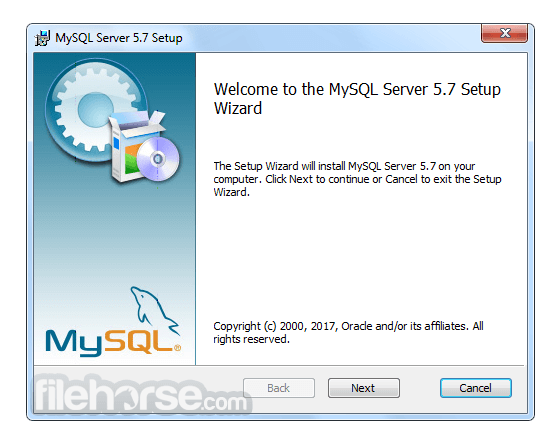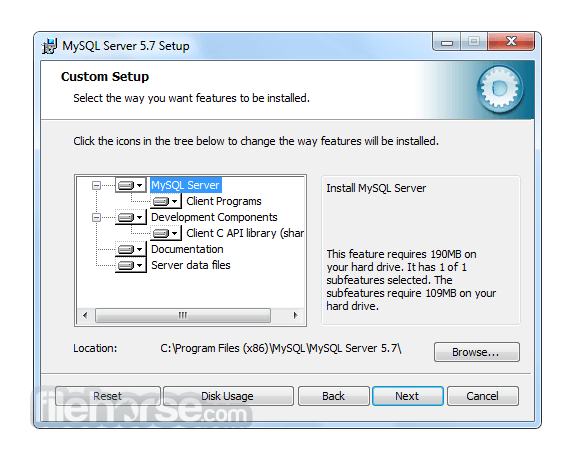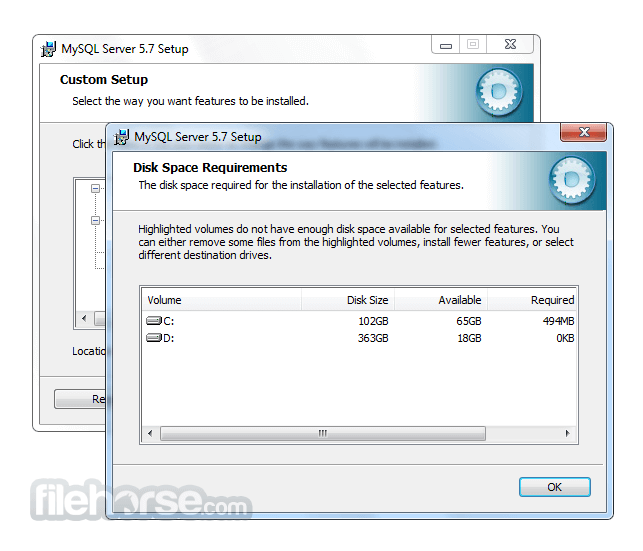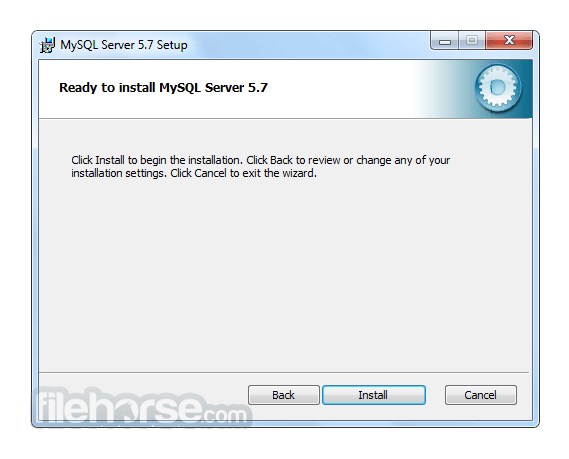-
Latest Version
-
Operating System
Windows XP / Vista / Windows 7 / Windows 8
-
User Rating
Click to vote -
Author / Product
-
Filename
mysql-5.5.29-win32.msi
-
MD5 Checksum
8fdca14daab15f52457ed020d2dde5a2
Sometimes latest versions of the software can cause issues when installed on older devices or devices running an older version of the operating system.
Software makers usually fix these issues but it can take them some time. What you can do in the meantime is to download and install an older version of MySQL 5.5.29 (32-bit).
For those interested in downloading the most recent release of MySQL or reading our review, simply click here.
All old versions distributed on our website are completely virus-free and available for download at no cost.
We would love to hear from you
If you have any questions or ideas that you want to share with us - head over to our Contact page and let us know. We value your feedback!
What's new in this version:
Functionality Added or Changed:
- The SHOW AUTHORS and SHOW CONTRIBUTORS statements are now deprecated in MySQL 5.5 and have been removed in MySQL 5.6.
Bugs Fixed:
- Performance: InnoDB: The timing values for low-level InnoDB read operations were adjusted for better performance with fast storage devices, such as SSD. This enhancement primarily affects read operations for BLOB columns in compressed tables.
- Important Change: InnoDB: A DML statement using the index merge access method could lock many rows from the table, even when those rows were not part of the final result set. This fix reduces the excessive locking by releasing the locks of unmatched rows. This optimization affects only transactions with isolation level equal to or less strict than READ COMMITTED; it does not apply to transactions using REPEATABLE READ or SERIALIZABLE isolation level.
- InnoDB: An online DDL operation for an InnoDB table incorrectly reported an empty value ('') instead of the correct key value when it reported a duplicate key error for a unique index using an index prefix.
- InnoDB: If a CREATE TABLE statement failed due to a disk full error, some memory allocated during the operation was not freed properly.
- InnoDB: With the innodb_file_per_table setting enabled, a DROP TABLE operation could cause a crash, due to a race condition that depended on the timing of pending I/O requests.
- InnoDB: If the server crashed at the specific point when a change buffer entry was being merged into a buffer pool page, the transaction log and the change buffer were left in an inconsistent state. After a restart, MySQL could crash after reading the corresponding secondary index page. The problem was more likely to occur in MySQL 5.5 or later, where the original insert buffering mechanism was generalized to cover other operations.
- InnoDB: Inserting data of varying record lengths into an InnoDB table that used compression could cause the server to halt with an error.
- InnoDB: If a table was defined with an index key length very close to the upper length limit of 3072, a query against that table could cause a serious error.
- InnoDB: When an auto-increment column used a FLOAT or DOUBLE data type, if the auto-increment value became very large (larger than the maximum unsigned long long value), subsequent inserts could fail or cause the server to halt.
- InnoDB: If a transaction was started with a consistent snapshot, then new indexes were added to the table while the transaction was in progress, a subsequent UPDATE statement could incorrectly encounter the error:
- HA_ERR_TABLE_DEF_CHANGED: insufficient history for index
- This issue could cause an assertion error in debug builds.
- InnoDB: The error message was improved for the case where an UPDATE failed because the row included several BLOB values greater than 768 bytes each, causing the size of a row to exceed half the page size. The old message, was misleading; it suggested using BLOBs, when the 768-byte prefix for each BLOB column was the cause of the limit error:
- Error Code 1118: Row size too large. The maximum row size for the used table type, not counting BLOBs, is 8126. You have to change some columns to TEXT or BLOBs
- A workaround for the problem was to create the table with the ROW_FORMAT=DYNAMIC or ROW_FORMAT=COMPRESSED clause, which is now suggested in the message.
- InnoDB: In rare circumstances, MySQL could apply InnoDB undo records out of order during a ROLLBACK of an operation that modified a BLOB column. This issue could cause an assertion error in debug builds:
- !bpage->file_page_was_freed
- Replication: Updates writing user variables whose values were never set on a slave while using --replicate-ignore-table could cause the slave to fail.
- Replication: Backtick (`) characters were not always handled correctly in internally generated SQL statements, which could sometimes lead to errors on the slave.
- Replication: Following an insert into a nontransactional table that failed due to insufficient disk space, the server did not properly clean up all pending events, leading to an assert or possibly to other errors.
- Very long database names in queries could cause the server to exit.
- Within a stored procedure, executing a multiple-table DELETE statement that used a very long table alias could cause the server to exit.
- Very long table aliases in queries could cause the server to exit.
- Attempting to create an auto-increment column in an InnoDB table with a NULL type attribute could cause a serious error.
- A DELETE statement for an InnoDB table could write incorrect transaction metadata into a record, causing the server to halt with an error. To work around this issue, reduce the specified length of the primary key to less than 1K bytes.
- Repeated execution of a query containing a subquery that used MAX() could result in increasing memory consumption.
- USE dbname could fail with Unknown database when dbname contained multiple backtick (`) characters.
- The configure.pl script that converts GNU configure options to CMake equivalents generated erroneous output for the --with-client-ldflags and --with-mysqld-ldflags options. It now ignores those options.
- SHOW PROFILE could be used to cause excessive server memory consumption.
- The thread cache implementation worked in LIFO rather than FIFO fashion and could result in a thread being denied service (although this was a remote possibility).
- Within a stored program, memory allocated to hold condition information was not released until program exit, leading to excessive memory use.
- Improper memory cleanup could cause the server to exit.
- Granting or revoking the PROXY privilege caused the server to exit if the server was started with --skip-name-resolve.
- CREATE USER and DROP USER could fail to flush the privileges, requiring FLUSH PRIVILEGES to be used explicitly.
- Access to INFORMATION_SCHEMA tables through a view could leak memory.
- A memory leak could occur for queries containing a subquery that used GROUP BY on an outer column.
- On Microsoft Windows with CMake 2.6, the build process would not stop if the create_initial_db step failed.
- The test in mysqld_safe for the presence of the --plugin_dir option and assignment of a default value to it were performed before the actual argument parsing took place.
- CHECK TABLE and REPAIR TABLE could crash if a MyISAM table had a corrupt key (.MYI) file. Now the server produces an error.
- Improper memory cleanup could cause the server to exit.
- A memory leak occurred due to failure to clean up after QUICK_INDEX_MERGE_SELECT/Unique.
- The number of connection errors from a given host as counted by the server was periodically reset, with the result that max_connect_errors was never reached and invalid hosts were never blocked from trying to connect.
- During optimization, ZEROFILL values may be converted to string constants. However, CASE expressions did not handle switching data types after the planning stage, leading to CASE finding a null pointer instead of its argument.
- In debug builds, an InnoDB assertion was overly aggressive about prohibiting an open range.
- On Windows, the Perl version of mysql_install_db created system tables in the mysql database that were not populated properly.
- mysqld_safe ignored the value of the UMASK environment variable, leading to behavior different from mysqld with respect to the access mode of created files. Now mysqld_safe (and mysqld_multi) attempt to approximate the same behavior as mysqld.
- LAST_INSERT_ID(expr) did not work for expr values greater than the largest signed BIGINT value.
 OperaOpera 118.0 Build 5461.41 (64-bit)
OperaOpera 118.0 Build 5461.41 (64-bit) PC RepairPC Repair Tool 2025
PC RepairPC Repair Tool 2025 PhotoshopAdobe Photoshop CC 2025 26.5.0 (64-bit)
PhotoshopAdobe Photoshop CC 2025 26.5.0 (64-bit) OKXOKX - Buy Bitcoin or Ethereum
OKXOKX - Buy Bitcoin or Ethereum iTop VPNiTop VPN 6.4.0 - Fast, Safe & Secure
iTop VPNiTop VPN 6.4.0 - Fast, Safe & Secure Premiere ProAdobe Premiere Pro CC 2025 25.2.1
Premiere ProAdobe Premiere Pro CC 2025 25.2.1 BlueStacksBlueStacks 10.42.51.1001
BlueStacksBlueStacks 10.42.51.1001 Hero WarsHero Wars - Online Action Game
Hero WarsHero Wars - Online Action Game SemrushSemrush - Keyword Research Tool
SemrushSemrush - Keyword Research Tool LockWiperiMyFone LockWiper (Android) 5.7.2
LockWiperiMyFone LockWiper (Android) 5.7.2










Comments and User Reviews